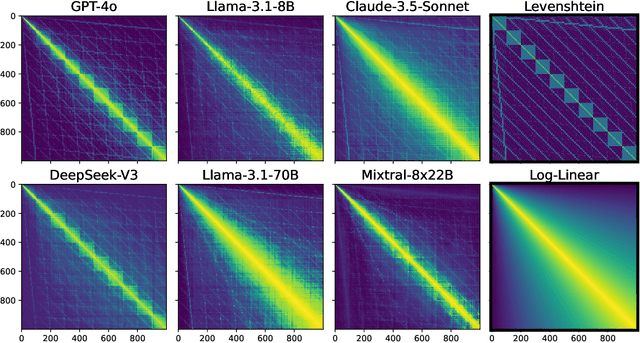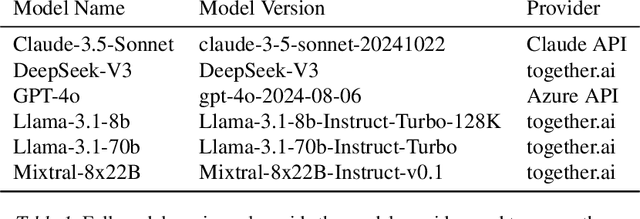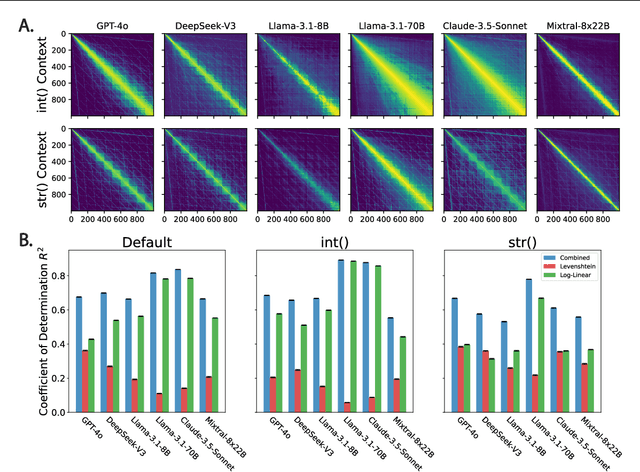Raja Marjieh
Using the Tools of Cognitive Science to Understand Large Language Models at Different Levels of Analysis
Mar 17, 2025Abstract:Modern artificial intelligence systems, such as large language models, are increasingly powerful but also increasingly hard to understand. Recognizing this problem as analogous to the historical difficulties in understanding the human mind, we argue that methods developed in cognitive science can be useful for understanding large language models. We propose a framework for applying these methods based on Marr's three levels of analysis. By revisiting established cognitive science techniques relevant to each level and illustrating their potential to yield insights into the behavior and internal organization of large language models, we aim to provide a toolkit for making sense of these new kinds of minds.
What is a Number, That a Large Language Model May Know It?
Feb 03, 2025



Abstract:Numbers are a basic part of how humans represent and describe the world around them. As a consequence, learning effective representations of numbers is critical for the success of large language models as they become more integrated into everyday decisions. However, these models face a challenge: depending on context, the same sequence of digit tokens, e.g., 911, can be treated as a number or as a string. What kind of representations arise from this duality, and what are its downstream implications? Using a similarity-based prompting technique from cognitive science, we show that LLMs learn representational spaces that blend string-like and numerical representations. In particular, we show that elicited similarity judgments from these models over integer pairs can be captured by a combination of Levenshtein edit distance and numerical Log-Linear distance, suggesting an entangled representation. In a series of experiments we show how this entanglement is reflected in the latent embeddings, how it can be reduced but not entirely eliminated by context, and how it can propagate into a realistic decision scenario. These results shed light on a representational tension in transformer models that must learn what a number is from text input.
Characterizing Similarities and Divergences in Conversational Tones in Humans and LLMs by Sampling with People
Jun 06, 2024Abstract:Conversational tones -- the manners and attitudes in which speakers communicate -- are essential to effective communication. Amidst the increasing popularization of Large Language Models (LLMs) over recent years, it becomes necessary to characterize the divergences in their conversational tones relative to humans. However, existing investigations of conversational modalities rely on pre-existing taxonomies or text corpora, which suffer from experimenter bias and may not be representative of real-world distributions for the studies' psycholinguistic domains. Inspired by methods from cognitive science, we propose an iterative method for simultaneously eliciting conversational tones and sentences, where participants alternate between two tasks: (1) one participant identifies the tone of a given sentence and (2) a different participant generates a sentence based on that tone. We run 100 iterations of this process with human participants and GPT-4, then obtain a dataset of sentences and frequent conversational tones. In an additional experiment, humans and GPT-4 annotated all sentences with all tones. With data from 1,339 human participants, 33,370 human judgments, and 29,900 GPT-4 queries, we show how our approach can be used to create an interpretable geometric representation of relations between conversational tones in humans and GPT-4. This work demonstrates how combining ideas from machine learning and cognitive science can address challenges in human-computer interactions.
Using Contrastive Learning with Generative Similarity to Learn Spaces that Capture Human Inductive Biases
May 29, 2024



Abstract:Humans rely on strong inductive biases to learn from few examples and abstract useful information from sensory data. Instilling such biases in machine learning models has been shown to improve their performance on various benchmarks including few-shot learning, robustness, and alignment. However, finding effective training procedures to achieve that goal can be challenging as psychologically-rich training data such as human similarity judgments are expensive to scale, and Bayesian models of human inductive biases are often intractable for complex, realistic domains. Here, we address this challenge by introducing a Bayesian notion of generative similarity whereby two datapoints are considered similar if they are likely to have been sampled from the same distribution. This measure can be applied to complex generative processes, including probabilistic programs. We show that generative similarity can be used to define a contrastive learning objective even when its exact form is intractable, enabling learning of spatial embeddings that express specific inductive biases. We demonstrate the utility of our approach by showing how it can be used to capture human inductive biases for geometric shapes, and to better distinguish different abstract drawing styles that are parameterized by probabilistic programs.
A Rational Analysis of the Speech-to-Song Illusion
Feb 10, 2024Abstract:The speech-to-song illusion is a robust psychological phenomenon whereby a spoken sentence sounds increasingly more musical as it is repeated. Despite decades of research, a complete formal account of this transformation is still lacking, and some of its nuanced characteristics, namely, that certain phrases appear to transform while others do not, is not well understood. Here we provide a formal account of this phenomenon, by recasting it as a statistical inference whereby a rational agent attempts to decide whether a sequence of utterances is more likely to have been produced in a song or speech. Using this approach and analyzing song and speech corpora, we further introduce a novel prose-to-lyrics illusion that is purely text-based. In this illusion, simply duplicating written sentences makes them appear more like song lyrics. We provide robust evidence for this new illusion in both human participants and large language models.
Comparing Abstraction in Humans and Large Language Models Using Multimodal Serial Reproduction
Feb 06, 2024



Abstract:Humans extract useful abstractions of the world from noisy sensory data. Serial reproduction allows us to study how people construe the world through a paradigm similar to the game of telephone, where one person observes a stimulus and reproduces it for the next to form a chain of reproductions. Past serial reproduction experiments typically employ a single sensory modality, but humans often communicate abstractions of the world to each other through language. To investigate the effect language on the formation of abstractions, we implement a novel multimodal serial reproduction framework by asking people who receive a visual stimulus to reproduce it in a linguistic format, and vice versa. We ran unimodal and multimodal chains with both humans and GPT-4 and find that adding language as a modality has a larger effect on human reproductions than GPT-4's. This suggests human visual and linguistic representations are more dissociable than those of GPT-4.
MacGyver: Are Large Language Models Creative Problem Solvers?
Nov 16, 2023



Abstract:We explore the creative problem-solving capabilities of modern large language models (LLMs) in a constrained setting. The setting requires circumventing a cognitive bias known in psychology as ''functional fixedness'' to use familiar objects in innovative or unconventional ways. To this end, we create MacGyver, an automatically generated dataset consisting of 1,600 real-world problems that deliberately trigger functional fixedness and require thinking 'out-of-the-box'. We then present our collection of problems to both LLMs and humans to compare and contrast their problem-solving abilities. We show that MacGyver is challenging for both groups, but in unique and complementary ways. For example, humans typically excel in solving problems that they are familiar with but may struggle with tasks requiring domain-specific knowledge, leading to a higher variance. On the other hand, LLMs, being exposed to a variety of highly specialized knowledge, attempt broader problems but are prone to overconfidence and propose actions that are physically infeasible or inefficient. We also provide a detailed error analysis of LLMs, and demonstrate the potential of enhancing their problem-solving ability with novel prompting techniques such as iterative step-wise reflection and divergent-convergent thinking. This work provides insight into the creative problem-solving capabilities of humans and AI and illustrates how psychological paradigms can be extended into large-scale tasks for comparing humans and machines.
Improving Interpersonal Communication by Simulating Audiences with Language Models
Nov 03, 2023Abstract:How do we communicate with others to achieve our goals? We use our prior experience or advice from others, or construct a candidate utterance by predicting how it will be received. However, our experiences are limited and biased, and reasoning about potential outcomes can be difficult and cognitively challenging. In this paper, we explore how we can leverage Large Language Model (LLM) simulations to help us communicate better. We propose the Explore-Generate-Simulate (EGS) framework, which takes as input any scenario where an individual is communicating to an audience with a goal they want to achieve. EGS (1) explores the solution space by producing a diverse set of advice relevant to the scenario, (2) generates communication candidates conditioned on subsets of the advice, and (3) simulates the reactions from various audiences to determine both the best candidate and advice to use. We evaluate the framework on eight scenarios spanning the ten fundamental processes of interpersonal communication. For each scenario, we collect a dataset of human evaluations across candidates and baselines, and showcase that our framework's chosen candidate is preferred over popular generation mechanisms including Chain-of-Thought. We also find that audience simulations achieve reasonably high agreement with human raters across 5 of the 8 scenarios. Finally, we demonstrate the generality of our framework by applying it to real-world scenarios described by users on web forums. Through evaluations and demonstrations, we show that EGS enhances the effectiveness and outcomes of goal-oriented communication across a variety of situations, thus opening up new possibilities for the application of large language models in revolutionizing communication and decision-making processes.
Getting aligned on representational alignment
Nov 02, 2023Abstract:Biological and artificial information processing systems form representations that they can use to categorize, reason, plan, navigate, and make decisions. How can we measure the extent to which the representations formed by these diverse systems agree? Do similarities in representations then translate into similar behavior? How can a system's representations be modified to better match those of another system? These questions pertaining to the study of representational alignment are at the heart of some of the most active research areas in cognitive science, neuroscience, and machine learning. For example, cognitive scientists measure the representational alignment of multiple individuals to identify shared cognitive priors, neuroscientists align fMRI responses from multiple individuals into a shared representational space for group-level analyses, and ML researchers distill knowledge from teacher models into student models by increasing their alignment. Unfortunately, there is limited knowledge transfer between research communities interested in representational alignment, so progress in one field often ends up being rediscovered independently in another. Thus, greater cross-field communication would be advantageous. To improve communication between these fields, we propose a unifying framework that can serve as a common language between researchers studying representational alignment. We survey the literature from all three fields and demonstrate how prior work fits into this framework. Finally, we lay out open problems in representational alignment where progress can benefit all three of these fields. We hope that our work can catalyze cross-disciplinary collaboration and accelerate progress for all communities studying and developing information processing systems. We note that this is a working paper and encourage readers to reach out with their suggestions for future revisions.
The Universal Law of Generalization Holds for Naturalistic Stimuli
Jun 14, 2023Abstract:Shepard's universal law of generalization is a remarkable hypothesis about how intelligent organisms should perceive similarity. In its broadest form, the universal law states that the level of perceived similarity between a pair of stimuli should decay as a concave function of their distance when embedded in an appropriate psychological space. While extensively studied, evidence in support of the universal law has relied on low-dimensional stimuli and small stimulus sets that are very different from their real-world counterparts. This is largely because pairwise comparisons -- as required for similarity judgments -- scale quadratically in the number of stimuli. We provide direct evidence for the universal law in a naturalistic high-dimensional regime by analyzing an existing dataset of 214,200 human similarity judgments and a newly collected dataset of 390,819 human generalization judgments (N=2406 US participants) across three sets of natural images.
 Add to Chrome
Add to Chrome Add to Firefox
Add to Firefox Add to Edge
Add to Edge